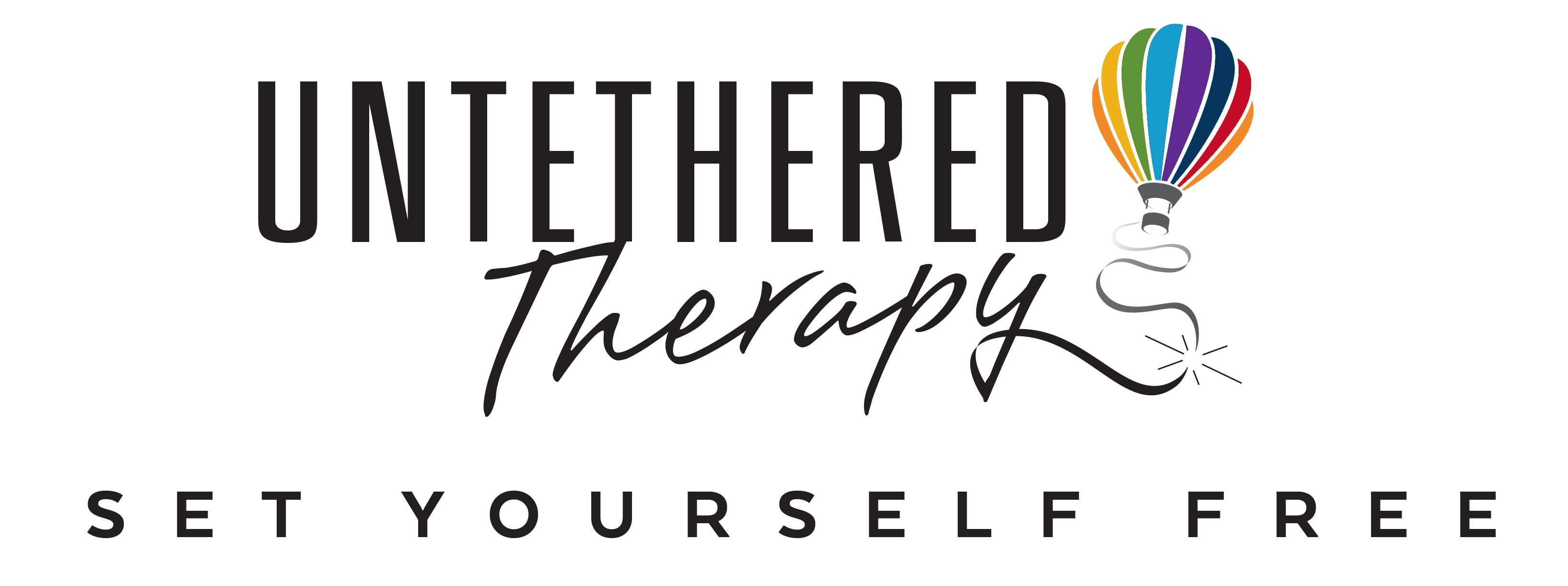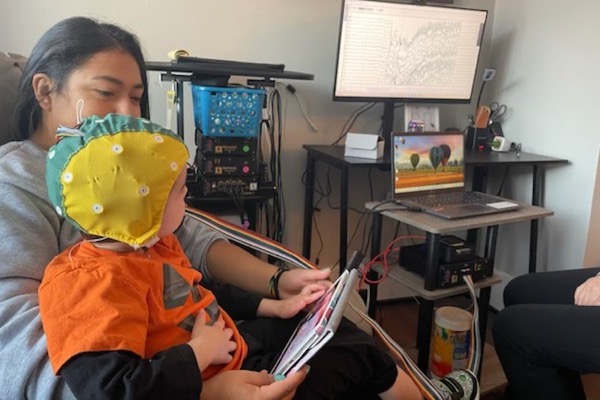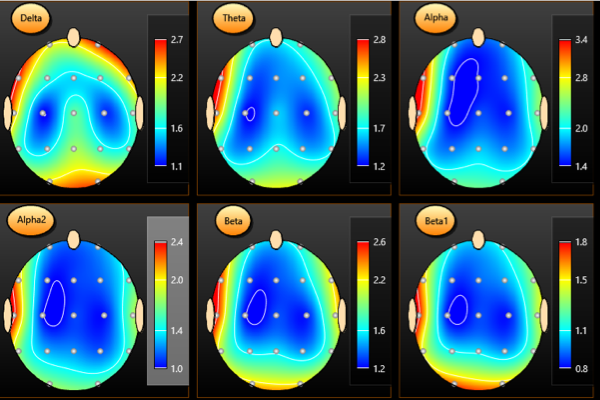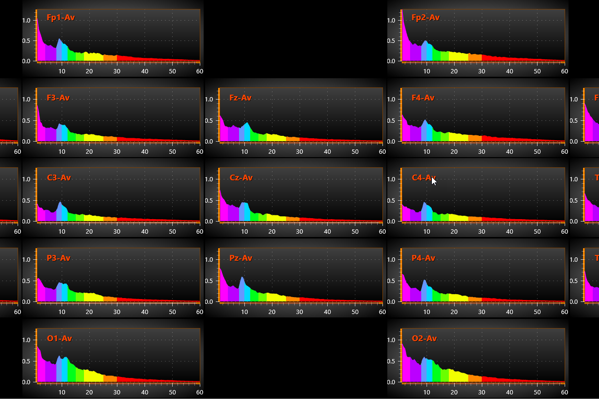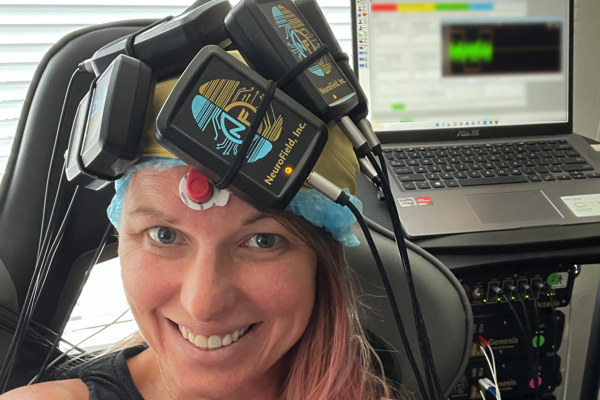
NEUROTHERAPY
Neurotherapy is a holistic form of therapy that uses non-invasive technology to improve brain function. Neurotherapy can incorporate Biofeedback (Neurofeedback) and/or Neuromodulation (Neurostimulation, also known as NIBS- Non-Invasive Brain Stimulation) technologies to help the brain get unstuck, process, communicate, and interpret information more efficiently. Neurotherapy can help to treat mental health disorders as a supplement to, or in place of, talk therapy or medication. It has been successfully used to treat many types mental health conditions including:
- Addiction
- Alzheimers/ Dementia/Cognitive Decline
- Anxiety
- Attention Deficit Hyperactive Disorder (ADHD)
- Autism
- Borderline Personality Disorder (BPD)
- Brain Fog, Fatigue, and Long Covid
- Chronic Pain
- Depression
- Dyslexia
- Insomnia and Sleep Disorders
- Neurodevelopmental Disorders
- Obsessive-Compulsive Disorder (OCD)
- Post-Traumatic Stress Disorder (PTSD)
- Schizophrenia
- Traumatic Brain Injury (TBI) / Post-Concussive Syndrome
NIBS also has benefits to improve peak performance in areas such as creativity, intuition and flow in healthy individuals.
Neurotherapy Assessments
Untethered Therapy uses state of the art equipment to collect and analyze brain activity and functioning through EEG, ERP (Event Related Potential) and Quantitative EEG (qEEG) Brain Mapping combined with comprehensive Neuro/Psycho/Social/Physiological assessments and interviews to identify the source(s) of they symptoms the client is experiencing and potential interventions. The results from the EEG, Brain Mapping and analysis are utilized to create an individualized treatment plan that is optimized to address the brain imbalances as well as refer out to additional specialists when necessary including: Neurologists, Functional Medical Doctors, Chiropractors, PCPs, Psychiatrists, and Endocrinologists to help the client get the answers and support they need to achieve their goals.
Neurotherapy Technology used at Untethered Therapy
We use a variety of Neurotherapeutic technologies including Neuro/Biofeeback (Neurofeedback, Heart Rate Variability) as well as Neuromodulation (Neurostimulation technologies including: Pulsed Electromagnetic Field (pEMF), Transcranial Alternating Current Stimulation (tACS), transcranial Direct Current Stimulation (tDCS), Transcranial Random Noise Stimulation (tR= NS) and Photobiomodulation, AKA: LED light therapy).
Neuromodulation
Neuromodulation, also known as Neurostimulation, is an active intervention utilizing the addition of a stimulus to entrain the brain to produce certain wavelengths, increase energy, or reduce inflammation utilizing a variety of technologies including: tDCS (Transcranial Direct Current Stimulation), tACS (Transcranial Alternating Current Stimulation), tRNS (Transcranial Random Noise Stimulation) and/or pEMF (Pulsed Electromagnetic Field). Neurostimulation has been shown to improve cognition, memory, problem-solving abilities, focus, insight, decision-making, depression, and mathematical and language learning skills.
tES- transcranial electrical stimulation (tES) – tDCS, tACS and tRNS
tDCS stands for Transcranial Direct Current Stimulation and is a form of neurostimulation (also known as neuromodulation). It’s a procedure that uses very low levels of electrical currents applied to the scalp that targets specific areas of the brain in order to enhance brain activity, often producing profound results. It has the distinct advantages of being inexpensive, easy to administer, noninvasive (it does not enter the body) and painless.
tACS (Transcranial Alternating Current Stimulation) is similar to tDCS as a neuromodulatory technique, but instead of applying a direct electrical current, tACS oscillates a sinusoidal current at a chosen frequency to interact with the brain’s natural cortical oscillations. Transcranial alternating current stimulation (tACS): from basic mechanisms towards first applications in psychiatry | SpringerLink
tRNS (Transcranial Random Noise) is a non-invasive noise stimulation that can increase synchronization of neural firing by amplifying the oscillatory activity and reducing the amount of internal noise particularly in the Brown Noise and Pink Noise frequencies. If a signal is too weak to induce action potential generation and random noise is added the improvement of the signal can lead to enhanced cognitive performance. Scaffolding the attention-deficit/hyperactivity disorder brain using transcranial direct current and random noise stimulation: A randomized controlled trial – ScienceDirect
Pulsed Electromagnetic Field (pEMF)
Pulsed Electromagnetic Field (pEMF) has been around for decades and been used by scientists around the world to study the effects of pEMF on organs and disease in the body. There are over 2,000 published clinical studies that show the benefit of pEMF on many different conditions. NeuroField’s FDA approved device is an ultra-low intensity, pulsed electromagnetic field (pEMF) unit that works to replenish energy and reduce stress in the brain and body. pEMF is purely electromagnetic and does not introduce direct current to the skin. The brain and body will “mimic” the pEMF fed into it and capillary blood flow will increase. Inflammation can limit the success of other types of biofeedback, pEMF can reduce inflammation and be given at fast speeds without generating heat and damaging tissue. pEMF can be used to entrain the brain via Operant conditioning or dis-entrain the brain via de habituation.
NeuroField’s pEMF has been documented as an intervention for insomnia, Parkinson’s disease, premenstrual dysphoric disorder, attention deficit disorder, anxiety, conduct disorder, and posttraumatic stress disorder. It has been shown in clinical studies to be an effective intervention for many other conditions and symptoms. Follow-up with the subjects of the studies and the clinical population has suggested that the changes hold over time.
Expanding Use of Pulsed Electromagnetic Field Therapies
A short review on the influence of magnetic fields on neurological diseases
PEMFs and cerebral ischemia: the pathways behind their beneficial effects
LED Light Therapy- Photobiomodulation (PBM)
LED Light therapy- Photobiomodulation (PBM) is a form of neuromodulation using LED light therapy at various wavelengths, typically Red Light Therapy (RLT) or Near Infrared Light Therapy (NIR) to improve brain functioning. Numerous research studies confirm the benefits of light therapy in treating many mental health and physical conditions including depression, anxiety and even alzheimers. In essence, red light therapy eliminates that lack of energy that accompanies low mood and anxiety. Red light therapy is known to increase the efficacy and integrity of mitochondria – the ‘powerhouse’ of the cell. This energy is then distributed where it is needed the most. One of the ways NIR may support your mental health is by stimulating areas of the brain that are linked to certain types of depression and anxiety. Namely, dlPFC and vmPFC play critical roles in the pathophysiology of depression. With well-calculated exposure to RLT and NIR, it is possible to modulate appropriate brain areas, so you can treat and improve the depression and anxiety symptoms.
Red light therapy has been shown to have the following direct and systemic effects that lead to reducing anxiety and mood improvement:
- Increased energy
- Harmonizing circadian rhythms
- Reducing inflammation
- Reducing oxidative stress
- Improving neurogenesis and synaptogenesis
Neurofeedback Training
Neurofeedback involves several electrodes/sensors being placed on the scalp and earlobes. Individual brain waves are measured and revealed on a computer screen revealing your brainwave activity. Through instruction you can learn to train down or train up certain brain waves associated with stress management, attentional, cognitive and/or emotional deficits and related disorders. Training lasts from 10-30 minutes and may occur two or more times per week for an average of 25-30, and in some cases 30 or more sessions.
“…the difference is mind blowing!!!”
“I am personally 21 sessions in so far and the difference is mind blowing!!! For the first time IN MY LIFE I am controlling my emotions and not the other way around. I can’t even believe I’m typing that! My brain is showing me the grace & kindness that it shows others for the first time…”
— Untethered Therapy Client
Frequently Asked Questions
Is Neurotherapy safe for kids and adults?
Neurotherapy has been used in safely in the treatment of adults and kids. For more information, please check out these papers:
Applications of transcranial direct current stimulation in children and pediatrics
Click here for access to more research on specific conditions.
Is Neurotherapy effective?
There has been a lot of research demonstrating the the effectiveness of neurotherapy on a variety of conditions including:
What is Neuromodulation Therapy & Technology? | Drake Institute
QEEG | Quantitative Electroencephalogram Test
Click here for access to more research on specific conditions.
What does a Neurotherapy session look like and how frequently do you need to do them?
Neurotherapy sessions are one hour long (30-40 minutes treatments, plus symptom tracking, and equipment set up and removal) and cost $150 each. It is important that your brain is well hydrated and fueled (have a high protein meal) before each treatment to maximize effects.
Neurotherapy is much like Physical therapy, it’s just specific to your brain, it is teaching your brain to work differently. Like PT it’s proven most effective when done 3 times per week. It’s important to know that when you start neurotherapy you must commit to three sessions a week for at least 3 weeks. The treatments last between 24- 48 hours and it’s crucial to keep your brain in constant training mode at first while it catches on, so to speak. After 3 weeks you can adjust your schedule if need be, but know that you will be committing to 3 times a week for at least 3 weeks.
Neurotherapy can also be done on an intensive basis which can be as frequent as twice/day with at least 1 hour between treatments with a food/water break to restore prior to the next session. Neurotherapy can also be intermingled with several other holistic modalities during intensive treatments including psychotherapy, trauma therapy (EMDR), therapeutic massage etc., depending on the needs of the client. The more frequent the sessions, the more quickly, and more dramatic the results will be. Intensive clients may travel and stay in the area for 1-2 weeks, depending on the case to make the greatest shifts in the least amount of time.
What does Neurotherapy cost and how many sessions will I need?
Neurotherapy and the QEEG scan are not covered by insurance but you can use HSA (Health Savings Accounts), or apply for a CARE Credit Card (zero interest for 2-3 years for medical expenses). This will help offset the costs of the initial assessments and treatments.
Just like working out, infrequent exercise is not likely to create long term benefits. Our goal is to help your brain receive the benefits of experiencing the benefits of Neurotherapy consistently enough that that your brain improves its ability to produce them by itself. Therefore a minimum commitment of 3 treatments/week (ideally spaced 24-48 hrs apart), for at least 3 weeks are necessary at the onset to get a sense of the difference Neurotherapy can make in your life.
NeuroFeedback (Neuro/Biofeedback) is very effective, but much slower in producing results compared to Neuromodulation. Whereas it may take 10-15 sessions for a client to notice changes produced by neurofeedback, clients receiving Non-Invasive Brain Stimulation/Neuromodulation (NIBS) can notice improvements in mood or sleep as early as the first treatment, significantly reducing the total number of treatments overall. Regardless of the treatment modality, consistent treatments will be necessary to create the long term shifts over time. Treatment effects generally last 24-48 hours and the initial goal is to “exercise” the brain frequently enough to receive the benefits. After 10-15 sessions , a secondary EEG will be taken to demonstrate brain changes and adjust protocols in order to give a better estimation of the total time needed to reach treatment goals.
Neurotherapy has been effectively used to treat a variety of neurodevelopmental, physical and psychological disorders, however the total length of treatment varies greatly depending on age, the overall metabolic and physical health, trauma, and severity of the impact. For example, clients with Autism will likely require more sessions than a client with mild depression or anxiety. Thorough interviews and initial assessments will provide an initial estimate of length of treatments, which will be updated with follow-up EEGs, every 10-15 sessions to ensure efficacy of the current treatment and modify the protocol for maximum efficiency.
Can I be on medication and still do Neurotherapy?
Yes. Neurotherapy is a non-invasive form of treatment. There are no contra-indications for medications and neurotherapy treatment. Since neurotherapy can increase blood flow to the brain, this may cause more of their medication to cross the blood/brain barrier, effectively resulting in an increased dose of the medication. If this occurs, clients may start to feel increased side effects of the medication and should consult with a doctor about possibly reducing the medication dose if side effects continue. Additionally, as clients receive increased benefits from neurotherapy, the improved functioning of their brain may result in a reduced need for the previously prescribed medication. Clients should let their doctor know they are receiving neurotherapy and consult closely with them regarding the possible reduction of medication over time as symptoms improve.
Are there any contraindications for Neurotherapy?
Yes. Clients with recent (6 weeks or less) head injuries that may have resulted in brain bleeding including, but not limited to: any form of head trauma, concussion, and especially stroke, should consult with a neurologist before beginning neurotherapy. Since neurotherapy is known to increase blood flow to the targeted area of the brain, stressed or damaged blood vessels in the brain should be given adequate time to heal before engaging in neurotherapy.
Clients with a history of seizures should let the clinician know before engaging in neurotherapy as they may be more sensitive to certain protocols than other clients.
What is the difference between transcranial direct and alternating current stimulation (tDCS/tACS) and Electroconvulsive therapy (ECT) since they both use electricity to treat the brain?
The main difference between the modalities is the level of intensity of the current used. The higher the voltage of the current, the more intense the impact is on the body and consequently the greater possibility for side-effects. Although all of these modalities are considered Non-Invasive compared to other modalities such as Deep Brain Stimulation (DBS), they have varying level of risk and benefits. Some clients will require more extreme stimulus, while it would be too much for others. Electroconvulsive Therapy (ECT) uses 180,000,000µV to 460,000,000 volts of electricity compared the the maximum voltage of 2.5 µV produced by our tDCS and tACS units. Despite large differences in voltage, tDCS and tACS have proven very effective in treating mental health conditions with lesser risk compared to their higher powered counterparts.
Safety of transcranial Direct Current Stimulation: Evidence Based Update 2016 – PMC
ECT, TMS and Other Brain Stimulation Therapies | NAMI: National Alliance on Mental Illness
What is the difference between rTMS versus pEMF therapies?
Both rTMS and pEMF neurotherapies use magnetic fields to produce change. Similar to ECT and tDCS, the main difference is the intensity of the field with rTMS being much stronger and can only be administered by qualified doctors and psychiatrists. Low voltage pEMF is an extremely gentle neuromodulation technology that can be used with children, yet has proven effective in child and adult populations to effect therapeutic change. We incorporate pEMF technology in our work at Untethered Therapy. For more information about the differences, check out the articles below:
What do I need to do to get started?
Contact our office for a free, 30 minute consultation to determine whether neurotherapy is right for you. If we move forward, the first step is setting up the initial QEEG along with an ERP (Event Related Potential) study, which is a deep dive into your brain functioning and health. We then analyze the data and figure out which protocol is best for you.
The initial assessments, QEEG, report and results session costs $1500 as it requires hours of interviews, assessments, and data analysis. After every 10-15 sessions you will do a follow up QEEG, for $500, to compare previous scans, track symptom improvement and determine if more work is needed. Depending on the trauma, history and diagnosis it varies on how many sessions one will need but the initial scan gives us a good idea. The more complex the case, the more sessions will be required. Minor cases of Depression or anxiety may resolve in 15-20 sessions, while clients with trauma or developmental disorders (Autism) will likely require 30 or more sessions.
In order to get a Baseline Brainscan, all patients need to be substance/medication free (when possible) for 48-72 hours prior to the scan. Alcohol and caffeine should be avoided 12-24 hours prior to the scan to get the best estimation of your brain’s substance free baseline functioning . Long term depression or medications that must be taken daily for medical purposes are permitted, but you must let the evaluator know what is in your system to prevent misinterpretation of the data. Finally, we want to see your brain at its best; therefore, we recommend scans to be done in the morning, with a well-rested, hydrated and fueled (protein rich meal) brain.
What is QEEG Brain Mapping & how to interpret it | Bitbrain
Event-related potential: An overview – PMC
A brief introduction to the use of event-related potentials in studies of perception and attention
